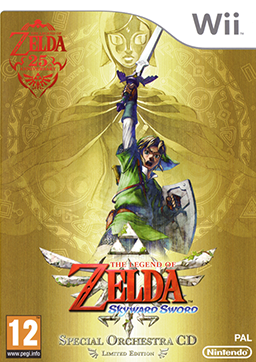The Legend of Zelda: Skyward Sword
| The Legend of Zelda: Skyward Sword | |
|---|---|

The Legend of Zelda 25th anniversary special edition box art released for all territories
|
|
| Developer(s) | Nintendo EAD |
| Publisher(s) | Nintendo |
| Director(s) | Hidemaro Fujibayashi |
| Producer(s) | Eiji Aonuma |
| Designer(s) | Ryuji Kobayashi |
| Writer(s) |
|
| Composer(s) |
|
| Series | The Legend of Zelda |
| Platform(s) | Wii,Wii U |
| Release date(s) | |
| Genre(s) | Action-adventure |
| Mode(s) | Single-player |
| Aggregate score | |
|---|---|
| Aggregator | Score |
| Metacritic | 93/100 (81 reviews) |
| Review scores | |
| Publication | Score |
| 1UP.com | B+ |
| Destructoid | 9.5/10 |
| Edge | 10/10 |
| EGM | 8.5 |
| Eurogamer | 10/10 |
| Famitsu | 40/40 |
| Game Informer | 10/10 |
| GameSpot | 7.5/10 |
| GamesRadar | |
| GameTrailers | 9.1/10 |
| IGN | 10/10 |
| Joystiq | |
| Nintendo Power | 9.5/10 |
| ONM | 98% |
| VideoGamer.com | 10/10 |
The Legend of Zelda: Skyward Sword is an action-adventure game for the Wii home console, developed and published by Nintendo. The sixteenth mainline entry in the The Legend of Zelda series, it was released worldwide in November 2011. Taking the role of series protagonist Link, players navigate the skies around the floating island of Skyloft and the land below it, completing quests that advance the story and solving environmental and dungeon-based puzzles. Gameplay mechanics and combat, the latter focusing on attacking and blocking with sword and shield, are reliant on the Wii MotionPlus expansion device.
Skyward Sword takes place at the beginning of the Zelda continuity, detailing the origins of the Master Sword, a recurring weapon within the series. The current incarnation of Link, resident of a floating town called Skyloft, heads on a quest to rescue his childhood friend Zelda after she is kidnapped and spirited to the Surface, an abandoned land below the clouds. Armed with the Goddess Sword and aided by a spirit named Fi, Link must ensure Zelda's safety and stop Ghirahim as he attempts to resurrect his master.
Development lasted around five years, beginning after the release of Twilight Princess in 2006. Multiple earlier Zelda games influenced the developers, including Twilight Princess, Ocarina of Time and Majora's Mask. Many aspects of the game's overworld and gameplay were designed to streamline and populate the experience for players. The art style was influenced by the work of impressionist painters including Paul Cézanne. The implementation of Wii MotionPlus proved problematic for the developers, to the point where it was nearly discarded. The music, composed by a team led by Hajime Wakai and supervised by Koji Kondo, was the first Zelda title to use a live orchestra for majority of the tracks.
...
Wikipedia
